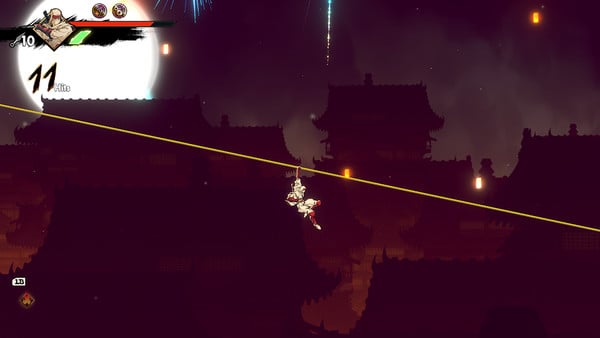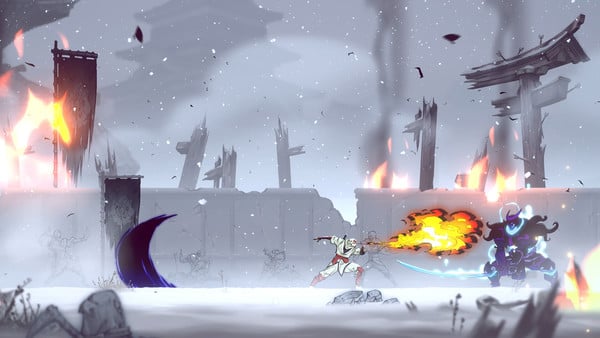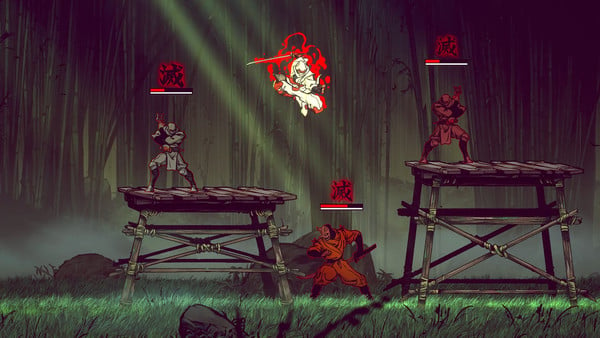Game Review
by George Yang,Shinobi: Art of Vengeance Game Review
Xbox Series X|S
| Description: |  |
||
Shinobi: Art of Vengeance is a 2D platformer game developed by Lizardcube, the studio behind Streets of Rage 4. It follows Joe Musashi of the Oboro Clan as he goes on a revenge quest against Lord Ruse and the ENE Corporation as they have eviscerated his hometown and its citizens. Along the way, he plans to stop Lord Ruse from taking over the world. |
|||
| Review: | |||
Shinobi: Art of Vengeance is the perfect balance between modern sensibilities and nostalgia, making it one of the best action-platformer games of 2025. This will inevitably gain comparisons to Koei Tecmo and The Game Kitchen's Ninja Gaiden: Ragebound which was released last year due to both utilizing similar ninja archetypes, story setups, and gameplay styles. However, they play entirely differently, granting Art of Vengeance an identity of its own. Like Ninja Gaiden: Ragebound, Shinobi: Art of Vengeance follows a familiarly typical revenge story but that doesn't distract from how fun and fluid both the combat and platforming are. As Joe Musashi, you have access to plenty of sword attacks and ninjutsu spells to cut down incoming enemies as you make your way through the different levels. One of the biggest differences between Ninja Gaiden: Ragebound and Shinobi: Art of the Vengeance is that the latter is much more of a Metroidvania than the former is. At the beginning of the game, you'll come across sections in levels where you simply don't have the tools to traverse through, such as Joe's hook, claws, and glider. As you progress through the story, however, you'll eventually gain access to them. This staple Metroidvania mechanic gives players an incentive to revisit older levels to find new upgrades and gear that can help Joe in battle. These include amulets that bestow effects like boosting your healing abilities or earn an extra gold coin with every other hit. The variety of effects lets you tweak your build to fit your preferred playstyle.  © SEGA Levels in this game tend to overstay their welcome, though. Metroidvania games usually have one giant map, but Art of Vengeance is split into the different levels and checkpoints are farther apart then I'd like. As such, pacing can feel obtuse and fatiguing at times. Thankfully, checkpoints can also be used as fast travel points. This makes it much easier to go back to previous sections in a level, and it's definitely a quality-of-life feature I appreciate as I don't have to run through an entire level from the start just to get to where I want to be. Art of Vengeance's art direction consists of gorgeous Japanese stylized brush strokes that give it a much more modern aesthetic compared to an 8-bit era where the series originated. As a result, combat looks readable even with all of the attacks flying all over the screen from Joe and foes alike. Joe Musashi's attacks feel both fast and powerful, and the additional combo attacks that you can purchase are incredibly satisfying. In particular, Joe can attack enemies above, below and even diagonally across from him, giving him much more flexibility than other 2D action-platformer contemporaries, and makes the combat feel much more up-to-date compared to them. To top it all off, Joe can throw kunai and unleash magic attacks like spitting out fireballs or summoning mult-hit lightning strikes with his blade, giving you even more options during battle.  © SEGA The defining feature of Art of Vengeance's combat, however, is the Shinobi Execution. Enemies have a separate execution bar apart from their HP that when filled up after taking successive attacks, makes a symbol appear on their heads. When that happens, Joe can perform a Shinobi Execution and kill them instantly, making for a satisfying and bloody finish to enemy encounters. Much like Ninja Gaiden: Ragebound's hypercharge mechanic, this adds a strategic element to Art of Vengeance's gameplay. The symbol doesn't go away, so you can divert your attention to other enemies and attack them so symbols pop up on them as well. So when you finally activate the Shinobi Execution, Joe destroys them all at once. There's even an incentive to do so, as enemies killed by this method drop extra gold and health restores orbs, increasing your chances of survival later in the level.  © SEGA In terms of replayability, there's a Boss Rush mode as well as an Arcade mode. The former is exactly as it sounds, letting you fight against bosses in succession. As for the latter, it hearkens back to the days of retro gaming where you can replay and complete levels for a score based on factors like how many times you died. It's a great way to test your skills and for anyone who's looking for an extra challenge or more activities to do after completing the story. Art of Vengeance can be a difficult game, but it offers accessibility options like being able to adjust how much damage enemies can do and how much HP they have. These options can take away from the game's potential challenge, but they open it up to more players with varying skill levels and reach a bigger audience. Shinobi: The Art of Vengeance is a fun 2D action-platformer that flawlessly blends Metroidvania style level design with fun combat. Composers Tee Lopes and Yuzo Koshiro's blend of classic Japanese music and rocking guitars for the soundtrack pulls the Shinobi series into the modern age and overall, Joe's latest adventure doesn't overly rely on nostalgia. The beautiful art direction and replayability options overshadow the game's flaws like pacing, making this a must-play game for both existing Shinobi fans and newcomers alike. |
| Grade: | |||
|
Overall : A
Graphics : A
Sound/Music : A
Gameplay : A+
Presentation : A
+ Explosive gameplay, clever use of Metroidvania level design, and strong art direction. |
|||
| discuss this in the forum (1 post) | | |||